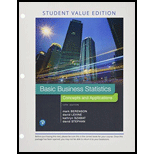
Concept explainers
You plan to conduct a marketing experiment in which student are to taste one of two different brands of soft drink. Their task is to correctly identify the brand tasted. You select a random sample of 200 students and assume that the students have no ability to distinguish between the two brands. (Hint: if an individual has no ability to distinguish between the two soft drinks, then the two brands are equally likely to be selected.)
a. What is the
b. The probability is
c. What is the probability that the sample percentage of correct identifications is greater than
d. Which is more likely to occur–more than
Want to see the full answer?
Check out a sample textbook solution
Chapter 7 Solutions
Basic Business Statistics, Student Value Edition
- 19. Let X be a non-negative random variable. Show that lim nE (IX >n)) = 0. E lim (x)-0. = >arrow_forward(c) Utilize Fubini's Theorem to demonstrate that E(X)= = (1- F(x))dx.arrow_forward(c) Describe the positive and negative parts of a random variable. How is the integral defined for a general random variable using these components?arrow_forward
- 26. (a) Provide an example where X, X but E(X,) does not converge to E(X).arrow_forward(b) Demonstrate that if X and Y are independent, then it follows that E(XY) E(X)E(Y);arrow_forward(d) Under what conditions do we say that a random variable X is integrable, specifically when (i) X is a non-negative random variable and (ii) when X is a general random variable?arrow_forward
 Holt Mcdougal Larson Pre-algebra: Student Edition...AlgebraISBN:9780547587776Author:HOLT MCDOUGALPublisher:HOLT MCDOUGAL
Holt Mcdougal Larson Pre-algebra: Student Edition...AlgebraISBN:9780547587776Author:HOLT MCDOUGALPublisher:HOLT MCDOUGAL



